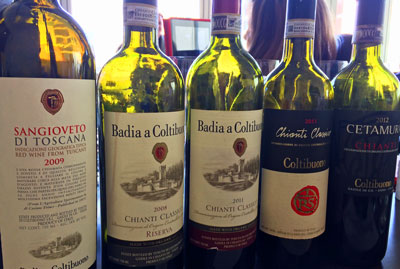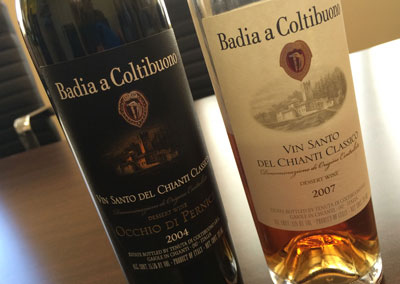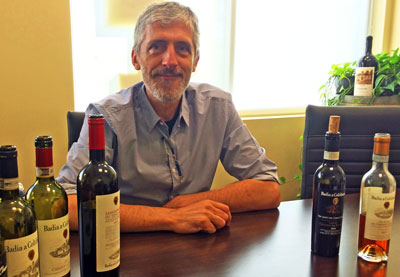
Tastes of Badia a Coltibuono: Wines that Entwine The Past and Future of Chianti Classico
I recently tasted a selection of wines of Badia a Coltibuono and met its general manager and winemaker Roberto Stucchi-Prinetti, the great grandson in the family that came to own this winery with a long legacy in the Chianti Classico region of Tuscany.
While tasting his initial offerings (value Chianti wines), Stucchi laid out a verbal picture of Badia a Coltibuono, which literally means “Abbey of Good Harvest” in an ancient dialect of Latin predating Italian. The abbey dates back to the 11th century being founded by a Tuscan order of Benedictine monks that established vineyards, a winery and a network of surrounding farms in the area near present-day Gaiole in Chianti.
In 1846, the abbey’s winery operation was secularized under the rule of Napoleon and in the late 1800s came into ownership of Piero Stucchi-Prinetti, Roberto’s great grandfather. It was largely due to Piero’s dedication and family support that the entire property began to flourish and survived the Second World War virtually intact. In the 1980s, with the aim to advance the winery’s business further Roberto came to California to study fermentation science at U.C. Davis. He later interned at Chappellet Vineyards in Napa Valley.
It would have been easy to get lost in the extensive history of Badia a Coltibuono and Roberto’s family story. However, the first two wines (Coltibuono Chianti Cetumura and Chianti Classico RS), both less than $15, snapped my attention back with refreshing, fruit-dominant, tart red cherry and aromatic floral notes highlighting little if any oak aging. And, for good reason, the Cetumura was recently named by Food & Wine Magazine’s Ray Isle to his list of “Amazing Wines for less than $15” (click here).
If wine drinking Texans are looking for a more personal linkage to Badia a Coltibuono, Roberto’s story gave it to me. He described a method of winegrowing/farming called “Promiscuo” that was in Italy and on his estate in the late-1800s when his great grandfather took control of the property. It used widely-spaced rows of grapes with other crops occupying the middles between the grapevines.
This agricultural approach is precisely the way another Italian family – The Qualias – newly arrived in Texas started their Val Verde Winery in 1883 in Del Rio, Texas (click here). This early approach to winegrowing encouraged different types of crops to co-exist side-by-side in the vineyard. In some cases, there would even be livestock bred on the estate. It was through this diversified Italian approach that Val Verde Winery survived and operated through prohibition and became the oldest continuously operated winery in Texas bringing with it a Mediterranean and Italian winemaking legacy to Texas. So, it is quite appropriate that Texan’s should sip and savor the wines of Badia a Coltibuono – kind of like a Mediterranean palate calibration.
The next three Badia a Coltibuono wines, ranging in price from $20 to $50 specifically featured the Badia a Coltibuono estate vineyard grapes (which are now organically grown), selections of best and ripest grapes, extended maceration and more extensive oak aging regimens:
Chianti Classico Estate – 90% Sangiovese – 10% Canaiolo Nero blend with 12 months of oak aging bringing intense red fruit and floral notes and highlights.
Chianti Classico Riserva – 90% Sangiovese – 10% Canaiolo Nero blend with still riper grapes with 24 months of oak aging to produce a deeper richer red berry flavors and aromas with highlights of wet earth and floral on the finish.
Sangioveto Di Toscano – 100% estate Sangiovese with 24 months of oak aging followed by 6 months of bottle aging before release offering darker color, black cherry, cola and wet-earthy notes with well-structured, pleasant tannins and spice on the finish.
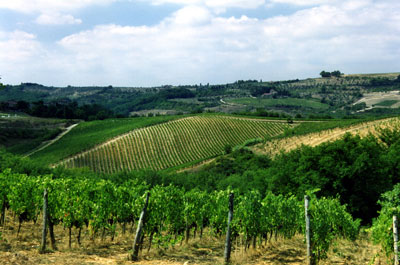
Roberto talked further about his opportunity coming to the study in the United States. He said, “I learned some very useful information particularly as we were trying to develop the winery into an ongoing business. But, I was also in California during the start-up of the organic movement, which helped me immensely. There, I learned that the soil was alive, it was a living entity. From that, I’ve been able to make our vineyards organically grown for over 20 years now. It definitely make things easier, particularly for disease resistance, and helps our yields particularly in bad years.”
Roberto also said, “I had the opportunity to replant the vineyard starting in 1988. I was able to screen the vineyard and select individual vines that we felt were doing the best on this historical site over a long period of time. We selected 600 vines and from those we decided to use certain ones for propagation that would be used to bring the best characteristics to the new replanted vineyard.” Roberto refers to these wines as his “heirloom” vines that reach back into the legacy of Badia a Coltibuono’ s past that he now uses to produce the wineries current and future wines.
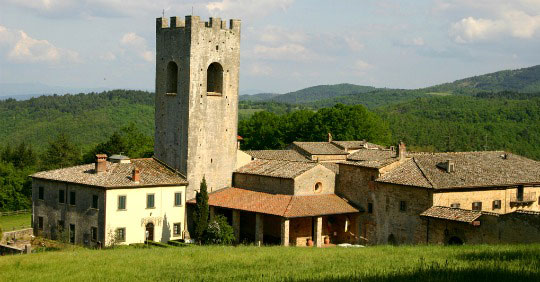
The last wines tasted were two Badia a Coltibuono Vin Santos. These are sweet wines made from early-harvested grapes with high acidity that are picked and then, in the “passito style”, let to air dry thus enhancing their sugar content to around 30 percent. Roberto refrained from calling them dessert wine. Rather, these are wines that are “guest wines”. They are oxidized and highly stable so you can keep a bottle open to serve when guests arrive as is the local custom in Tuscany.
The first of these wines was their Vin Santo del Chianti Classico made in the traditional manner from white Trebbiano and Malvasia grapes and allowed to age in small sealed oak barrels for four years under ambient conditions. The wine had an amber color and yielded honeyed characteristics appointed with roasted hazelnut qualities. The second Vin Santo was a special wine (called “Occhio di Pernice” – or “Partridge Eye” owing to its color) made from Sangiovese grapes and oak aged for five years. This wine presented a garnet red color with a rim of amber (like the Partridge’s eye) with nuances of honey, candied citrus fruit and savory, nutty and earthy notes.
In closing, Roberto spoke of his fortune to have interned at Chappellet Vineyards in Napa Valley before going back to Italy to work on modernizing his family’s vineyard and winery. This internship was a special opportunity since the Chappellet family’s development of their Pritchard Hill Vineyard was all about learning and identifying a vineyard site’s particular elements that defined its terroir (or sense of place). These are the set of special characteristics of geography, geology and climate of a certain place and how they interacting with plant genetics that are expressed in the wine. The skills learned at Chappellet and later applied at Badia a Coltibuono were precisely what have brought him his current successes and have also produced enjoyment for the many that drink his wines now and that will for decades to come.
